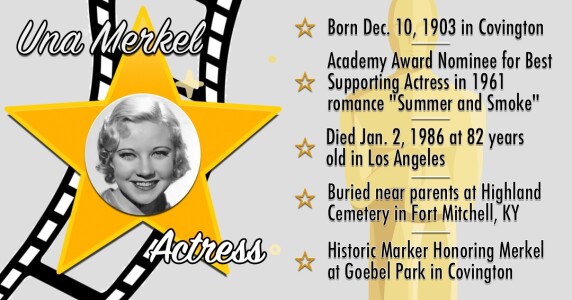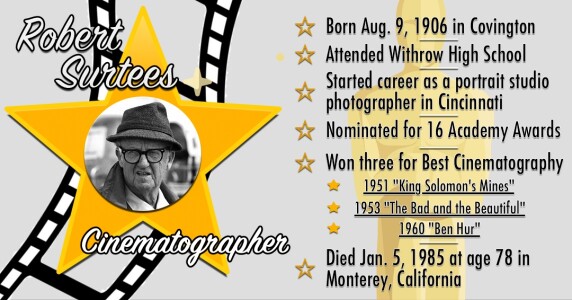CINCINNATI — If the Oscar statuette is ever given a crown, it should come from the Queen City.
The region's contribution to cinema is as epic as some of the blockbusters Hollywood produces. And that tradition goes back further than the spate of recent movies filmed in Greater Cincinnati or even the filming of "Rain Man" 30 years ago.
Take a look back at nine cinematic history makers who once called Cincinnati home.
AND THE NOMINEES ARE . . .
These are the actors with local ties who almost took home an Oscar (and probably should have).

Not only was Doris Day a beloved homegrown star, she was a Hollywood icon known for her singing, acting and humanitarian efforts. Day might have never received an Oscar but she more than made up for it with at least two other lifetime achievement awards for her work. Day died Monday at the age of 97.

Una Merkel is one of the few early Hollywood actresses to successfully transition from silent films to the "talkies." Critics attribute Merkel's success to her Kewpie doll looks, Southern accent and wry line delivery, which often landed her comedic supporting roles. Merkel experienced her greatest critical success on Broadway, where in 1956 she won a Tony Award for her role in "The Ponder Heart."
THE WINNERS ARE . . .

There is no denying that Northern Kentucky native George Clooney deserves to be at the top of this list. At 57, the son of former local news anchor Nick Clooney and nephew of iconic actress Rosemary Clooney has earned quite a few Academy Award nominations and wins. Clooney has plenty of time to add a couple more Oscar statues to his collection as well.
RELATED: 9 times celebrities showed Cincinnati love

Charles Guggenheim may not be a familiar name to the casual movie watcher but the Cincinnati native definitely left his mark on documentary film making. Rather than work for his family's successful Cincinnati furniture manufacturing business, Guggenheim decided to pursue a career behind a film camera. He initially pursued a broadcasting career in New York and later founded his own film production company. Guggenheim went on to win kudos and long list of awards for the documentary shorts he either wrote, directed or produced.

Robert Surtees worked his way from the very bottom of his chosen career path to become one of cinema's most revered cinematographers. By the end of his career, Surtees earned 16 Academy Award nominations, starting with "Thirty Seconds Over Tokyo" in 1944 and his last for "The Turning Point" in 1977. During the 33 years in between, Surtees won three Academy Awards for Best Cinematography. Other notable nominations included his work on "The Graduate," "The Last Picture Show" and "The Sting."

You have George Chakiris to thank if you've ever caught yourself snapping your fingers while rhythmically waving your arms in a mock-dance off or fight. Chakiris won his sole Academy Award for playing Bernardo, the leader of rival street gang the Sharks in the Academy Award-winning musical "West Side Story." Chakiris owed a big part of his successful career as a dancer and actor to a chance promotional still he appeared in with Rosemary Clooney for the movie "White Christmas." Chakiris couldn't get signed with a major studio at the time. He was only offered a studio contract after someone saw him as an unbilled extra dancing with Clooney in the picture.
SPECIAL ACHIEVEMENT AWARDS
The Queen City has also produced some people who deserve special recognition, even if they've never been recognized by the Academy through a nomination.

There is a logical reason why Theda Bara was never recognized by the Academy. The star of dozens of silent films retired from acting in 1926, three years before the first Academy Awards ceremony took place. Bara's influence though echoed throughout Hollywood, especially during its studio-system era, decades after she last appeared on the silver screen.

Bara's public persona was a construction based on sexual and racial stereotypes built by studio executive that made her the most popular actress in silent films. That persona also helped create the "Vamp" or dangerous woman character that still appears in Hollywood films. Looking at a few old film posters though, a modern audience might see a strong woman instead of a dangerous one (though some critics might argue certain men conflate the two).

In a 1990s interview with the Los Angeles Times, Academy Award-winning actor Sidney Poitier named Louise Beavers within a group of black actors who not only managed to appear on the silver screen but pushed the racial boundaries of their time.
"The guys who were forerunners to me, like Canada Lee, Rex Ingram, Clarence Muse and women like Hattie McDaniel, Louise Beavers and Juanita Moore, they were terribly boxed in," Poitier said then. "They were maids and stable people and butlers, principally. But they, in some way, prepared ground for me."
Beavers spent most of her acting career relegated to the role of maid or servant to her white counterparts on the silver screen. Within those confines though, Beavers was still occasionally able to display her depth of talent and test white stereotypes of African Americans. Her portrayal of Delilah Johnson in the 1934 film "Imitation of Life" led to heated public discussion about why the actress did not receive a nomination for Best Supporting Actress the following year.

There is no indication that the Academy ever seriously considered nominating Evelyn Venable for one of its awards. The congenial star (by most accounts) did land a few very interesting roles before retiring from acting in the 1940s. For one thing, anyone who has ever watched Disney's "Pinocchio" knows Venable's voice as The Blue Fairy who brought the wooden puppet to life. She also carried a torch for Columbia Pictures for decades as the model for the studio's logo that appeared before each of its films. Venable's post-acting career was also impressive. How many people can say they quit a lucrative acting career to pursue a college education in order to become a university faculty member?

